国外大牛的图像修复综述
图像超分辨率重建算法研究文献综述

图像超分辨率重建算法研究文献综述图像超分辨率重建是一种通过图像增强技术将低分辨率图像转换为高分辨率图像的方法。
在计算机视觉领域,图像超分辨率重建技术具有广泛的应用,如监控视频分析、医学图像诊断和卫星图像分析等。
本文将对图像超分辨率重建算法的研究文献进行综述,包括传统方法和基于深度学习的方法。
传统方法主要基于插值和信号处理技术,如双三次插值、基于边缘的插值和基于局部统计的插值等。
这些方法主要通过将低分辨率图像的像素进行插值来增加图像的分辨率,但其效果有限。
近年来,基于深度学习的图像超分辨率重建方法取得了显著的进展。
主要有以下几种方法:1. SRCNN(Super-Resolution Convolutional Neural Network):SRCNN是一种使用卷积神经网络进行图像超分辨率重建的方法。
它通过学习低分辨率图像到高分辨率图像的映射关系来进行重建。
SRCNN模型包括三个卷积层和一个像素重构层,可以在保持高分辨率细节的情况下,有效地提高图像的分辨率。
2. SRGAN(Super-Resolution Generative Adversarial Network):SRGAN是一种将生成对抗网络应用于图像超分辨率重建的方法。
它通过引入生成器和判别器网络来优化图像重建过程。
生成器网络负责将低分辨率图像转换为高分辨率图像,判别器网络则负责评估生成器网络的输出图像是否与真实高分辨率图像相似。
通过不断迭代训练,SRGAN可以生成更高质量的重建图像。
3. ESPCN(Efficient Sub-Pixel Convolutional Neural Network):ESPCN是一种高效的子像素卷积神经网络。
它通过将低分辨率图像放大到目标分辨率的多倍,然后使用卷积神经网络来提取高频信息。
相比于其他方法,ESPCN具有更少的网络参数和计算复杂度。
4. EDSR(Enhanced Deep Residual Networks):EDSR是一种基于残差网络的图像超分辨率重建方法。
【图像复原技术研究文献综述2000字】

图像复原技术研究国内外文献综述作为日常生活中广泛使用的技术,图像修复技术汇集了国内外许多重要技术。
实际上,图像复原分为三种标准:首先是搭建其劣化图像的图像模型;其次去研究和筛选最佳的图像复原方法;最后进行图像复原。
所有类型的成像模型和优化规则都会导致应用于不同领域的不同图像恢复算法。
我们对现有的图像复原方法大致做了总结,如利用线性代数知识的线性代数复原技术、搭建图像退化模型的去卷积图像恢复技术以及不考虑PSF的图像盲解卷积算法等。
其中,去卷积方法主要包括功率谱均衡、Wiener滤波和几何平均滤波等,然而这些方法需要许多预信息和噪声稳定假设,这在现实当中我们不可能利用计算机去做到的的事情,因此它们只适用于线性空间不变的理想系统,仅当噪声与信号无关时才能达到很好的效果。
但是在一些条件恶化的情况下,就不能满足图像修复的效果了。
在图像恢复领域当中,另一个重要且常见的方法是盲去卷积复原法。
它的优势是在没有预先了解退化函数和实际信号的知识前提下,可以根据劣化图像直接估计劣化函数和初始信号。
实际上,现在有几个算法通过不充分的预测信息来恢复劣化图像。
由于我们需要对图像和点扩展函数的一些相关信息进行假设和推导,所以这就导致图像恢复的解通常并不存在唯一性,并且我们已知的初始条件和对附加图像假设的选择也会对解的优劣产生很大的关系。
与此同时,由于信道中不可避免的加性噪声的影响,会进一步导致盲图像的复原变差,给图像复原造成许多困难。
也就是说,如果我们直接利用点扩展函数进行去卷积再现初始图像,则一般会导致高频噪声放大,导致算法的性能恶化,恢复不出清晰的图像。
因此,我们要尽可能的提高图像的信噪比,从而提高图像复原的效果。
基于已知的降质算子和加性噪声的某些统计性质从而恢复清晰的图像,我们将这种方法叫做线性代数恢复方法,并且这种线性代数恢复方法在一定程度上提出了用于恢复滤波器的数值计算从而使得模糊图像恢复到与清晰图像一致的新的设计思想。
深度学习图像修复总结汇报(Shift-Net、Deep Fusion Net)
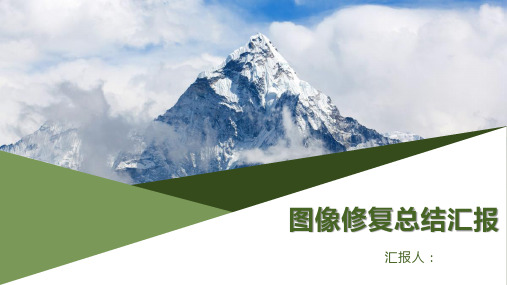
一、 Shift Net
由公式可以看出作者希望给解码器提供一个约束,目的是让解码器能够缓解之前提到的 U-Net的讲mask引入decoder的问题,不过这个损失的引入只是在一定程度上能够缓解这个 问题,并不能完全杜绝这个问题,相比之下上次汇报讲的那个PEN-Net使用的ATN网络的方 法直接杜绝了这个问题,但是同时提高了算力的需求,因此在使用时具体要使用哪种方式需 要权衡需要。
二、Pluralistic Image Completion
2.网络结构 为了直观的向大家展现双通道的结构和数据流向,作者用了两个概念图来
表现,下面左图是作者网络的宏观概念图,右图是网络细节,橘黄色的线是训练 路径,蓝色是测试路径。
二、Pluralistic Image Completion
2.网络结构 从数据流向上我们就可以看出作者的意图了,训练支路利用被mask覆盖的
一、 Shift Net
3.总结 这篇论文利用的shift操作是以前patch-base方法的变种,有效的缓解了使用重构误差和GAN 损失只能较好的还原语义和结构,无法生成细致纹理的问题,另外提出的guidance loss有效 的缓解了mask引入decoder的问题,因此在2018年的时候在定量分析上获得了当时最佳的成 绩。 顺带一提,由于图像修复任务目前研究的重点目前基本已经确定在生成器的改良上,至于判 别器,目前主流如果算力允许就采用PatchGAN架构,如果算力不允许大多采用wgan-gp架 构,GAN损失的搭建基本相同,因此我觉得没有必要在介绍论文时每次都重复一次,因此在 此处不再赘述,论文中完整的损失包含了guidance loss,gan loss以及生成器输出的l1重构 损失三个损失。 总的来说,这篇论文提供了一个计算量相对较小的缓解U-Net瓶颈的问题,在一些算力不足 的场合还是很有实用意义的。
浅述图像修复技术的发展
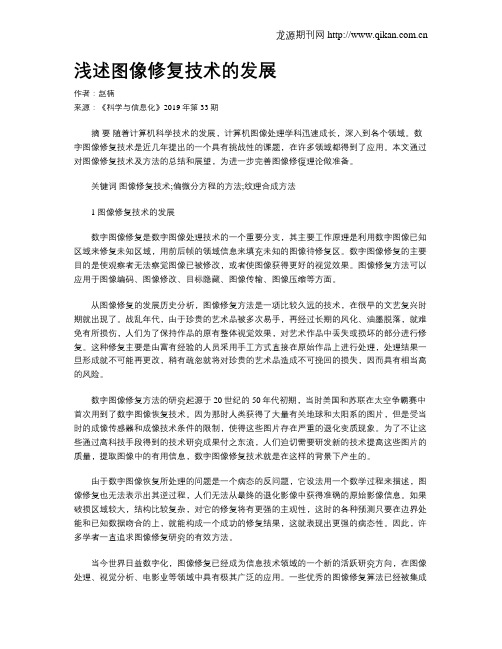
浅述图像修复技术的发展作者:赵楠来源:《科学与信息化》2019年第33期摘要随着计算机科学技术的发展,计算机图像处理学科迅速成长,深入到各个领域。
数字图像修复技术是近几年提出的一个具有挑战性的课题,在许多领域都得到了应用。
本文通过对图像修复技术及方法的总结和展望,为进一步完善图像修復理论做准备。
关键词图像修复技术;偏微分方程的方法;纹理合成方法1 图像修复技术的发展数字图像修复是数字图像处理技术的一个重要分支,其主要工作原理是利用数字图像已知区域来修复未知区域,用前后帧的领域信息来填充未知的图像待修复区。
数字图像修复的主要目的是使观察者无法察觉图像已被修改,或者使图像获得更好的视觉效果。
图像修复方法可以应用于图像编码、图像修改、目标隐藏、图像传输、图像压缩等方面。
从图像修复的发展历史分析,图像修复方法是一项比较久远的技术,在很早的文艺复兴时期就出现了。
战乱年代,由于珍贵的艺术品被多次易手,再经过长期的风化、油墨脱落,就难免有所损伤,人们为了保持作品的原有整体视觉效果,对艺术作品中丢失或损坏的部分进行修复。
这种修复主要是由富有经验的人员采用手工方式直接在原始作品上进行处理,处理结果一旦形成就不可能再更改,稍有疏忽就将对珍贵的艺术品造成不可挽回的损失,因而具有相当高的风险。
数字图像修复方法的研究起源于20世纪的50年代初期,当时美国和苏联在太空争霸赛中首次用到了数字图像恢复技术。
因为那时人类获得了大量有关地球和太阳系的图片,但是受当时的成像传感器和成像技术条件的限制,使得这些图片存在严重的退化变质现象。
为了不让这些通过高科技手段得到的技术研究成果付之东流,人们迫切需要研发新的技术提高这些图片的质量,提取图像中的有用信息,数字图像修复技术就是在这样的背景下产生的。
由于数字图像恢复所处理的问题是一个病态的反问题,它设法用一个数学过程来描述,图像修复也无法表示出其逆过程,人们无法从最终的退化影像中获得准确的原始影像信息。
图像修复的新方法研究

图像修复的新方法研究图像修复是计算机视觉领域的热门研究方向之一。
随着计算机技术的快速发展,人们对图像修复技术的需求也越来越高。
传统的图像修复方法主要依靠人工干预,需要大量的时间和精力。
近年来,随着深度学习的兴起,图像修复的新方法也逐渐被研究和应用。
深度学习是一种以人工神经网络为基础的机器学习方法。
它通过训练大量的数据,自动学习图像的特征和规律,从而实现图像修复的目的。
与传统的方法相比,深度学习具有以下优势:首先,深度学习可以自动提取图像中的特征,无需人工干预。
其次,深度学习可以处理大规模的数据,具有较高的效率和准确性。
最后,深度学习可以通过不断的训练和优化,提高图像修复的效果。
在图像修复的研究中,研究人员提出了一种基于生成对抗网络(GAN)的新方法。
生成对抗网络是一种由生成器和判别器组成的网络结构,通过不断的博弈和对抗学习,提高图像修复的效果。
生成器负责生成修复后的图像,判别器则负责判断生成的图像与原始图像之间的差异。
通过不断的迭代训练,生成器和判别器可以相互协作,提高图像修复的准确性和真实性。
除了生成对抗网络,研究人员还提出了一种基于自编码器的图像修复方法。
自编码器是一种由编码器和解码器组成的网络结构,通过将原始图像编码为低维特征向量,然后解码为修复后的图像。
自编码器可以通过训练大量的数据,学习图像的特征和规律,从而实现图像修复的目的。
相比于生成对抗网络,自编码器更加简单和直观,但在一些复杂的图像修复任务上可能效果不如生成对抗网络。
总之,图像修复的新方法研究正在取得令人瞩目的进展。
深度学习的兴起为图像修复提供了新的思路和方法。
生成对抗网络和自编码器等新方法在图像修复中展现出了巨大的潜力。
随着技术的不断发展和突破,相信图像修复的效果还会进一步提升,为人们带来更加清晰和真实的图像体验。
采用双线性插值收缩的图像修复方法
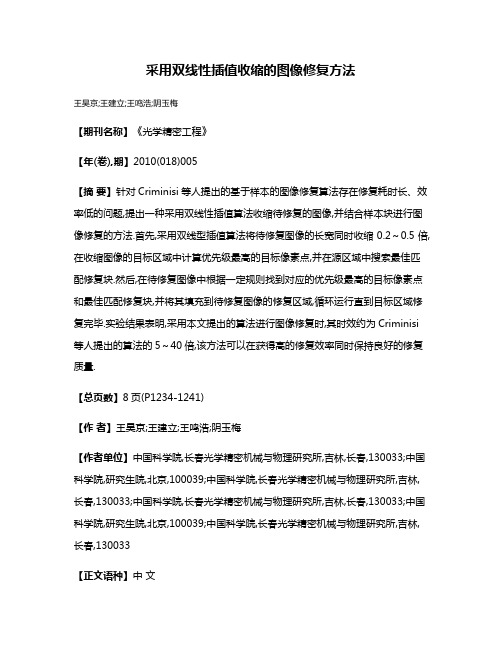
采用双线性插值收缩的图像修复方法王昊京;王建立;王鸣浩;阴玉梅【期刊名称】《光学精密工程》【年(卷),期】2010(018)005【摘要】针对Criminisi等人提出的基于样本的图像修复算法存在修复耗时长、效率低的问题,提出一种采用双线性插值算法收缩待修复的图像,并结合样本块进行图像修复的方法.首先,采用双线型插值算法将待修复图像的长宽同时收缩0.2~0.5倍,在收缩图像的目标区域中计算优先级最高的目标像素点,并在源区域中搜索最佳匹配修复块.然后,在待修复图像中根据一定规则找到对应的优先级最高的目标像素点和最佳匹配修复块,并将其填充到待修复图像的修复区域,循环运行直到目标区域修复完毕.实验结果表明,采用本文提出的算法进行图像修复时,其时效约为Criminisi 等人提出的算法的5~40倍,该方法可以在获得高的修复效率同时保持良好的修复质量.【总页数】8页(P1234-1241)【作者】王昊京;王建立;王鸣浩;阴玉梅【作者单位】中国科学院,长春光学精密机械与物理研究所,吉林,长春,130033;中国科学院,研究生院,北京,100039;中国科学院,长春光学精密机械与物理研究所,吉林,长春,130033;中国科学院,长春光学精密机械与物理研究所,吉林,长春,130033;中国科学院,研究生院,北京,100039;中国科学院,长春光学精密机械与物理研究所,吉林,长春,130033【正文语种】中文【中图分类】TP391.41【相关文献】1.一种适用于不同型号偶丝的数据处理方法:双线性插值方法 [J], 李彦明;孙长森2.采用二次收敛的低速扇形叶栅收缩段设计方法研究 [J], 陆华伟;王旭;郭爽;钟兢军;陈浮3.采用现象学方法探讨约束因素对混凝土收缩的影响 [J], 孙南屏4.采用双线性插值算法重采样生成核线影像 [J], 廉琦;黄德伦;孙立军5.一种采用纹理结构联合似然约束的图像修复算法的研究 [J], 李威;张福明;卢文超;许文丽因版权原因,仅展示原文概要,查看原文内容请购买。
图像修复研究进展综述
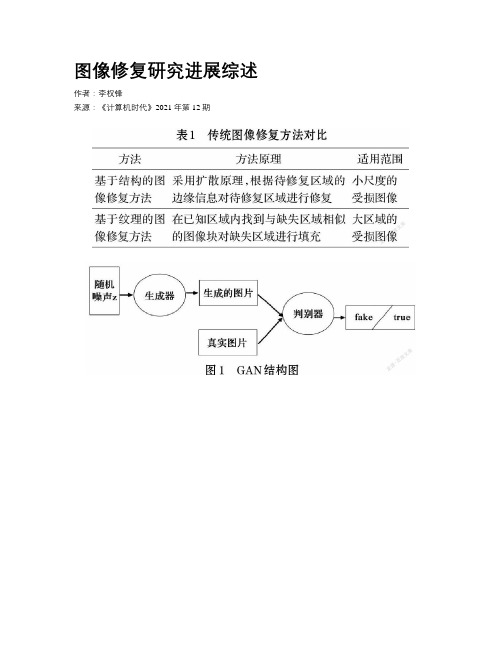
图像修复研究进展综述作者:***来源:《计算机时代》2021年第12期摘要:图像修复是指将信息缺失的图像进行像素填充以达到人类视觉满意的效果。
文章对该领域研究的相关技术进行综述:首先描述了传统的图像修复方法,接着描述了基于深度学习的图像修复方法,介绍各类方法的适用范围及优缺点,最后对未来的研究方向及重点提出展望。
关键词:图像修复; 深度学习; 卷积神经网络; 自编码网络; 生成式对抗网络中图分类号:TP391.4 文献标识码:A 文章编号:1006-8228(2021)12-06-04Abstract: Image restoration is to fill the missing image with pixels to achieve the satisfactory effect of human vision. This paper reviews the related technologies in this field: firstly, it describes the traditional image restoration methods, and then describes the image restoration methods based on deep learning, introduces the application scope, advantages and disadvantages of various methods, and finally puts forward the prospect of future research direction and focus.Key words: image restoration; deep learning; convolutional neural network; self-coding network; generative adversarial network0 引言生活离不开图像,图像作为反映客观世界的重要载体,是人类接收外界信息的重要来源和手段。
一种改进的数字图像修复方法
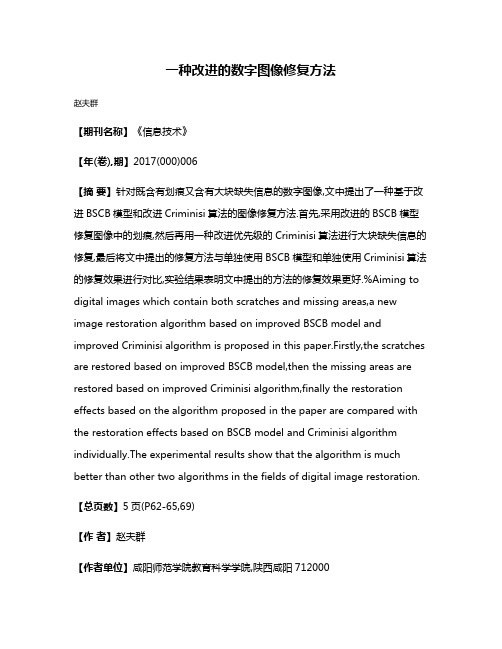
一种改进的数字图像修复方法赵夫群【期刊名称】《信息技术》【年(卷),期】2017(000)006【摘要】针对既含有划痕又含有大块缺失信息的数字图像,文中提出了一种基于改进BSCB模型和改进Criminisi算法的图像修复方法.首先,采用改进的BSCB模型修复图像中的划痕,然后再用一种改进优先级的Criminisi算法进行大块缺失信息的修复,最后将文中提出的修复方法与单独使用BSCB模型和单独使用Criminisi算法的修复效果进行对比,实验结果表明文中提出的方法的修复效果更好.%Aiming to digital images which contain both scratches and missing areas,a new image restoration algorithm based on improved BSCB model and improved Criminisi algorithm is proposed in this paper.Firstly,the scratches are restored based on improved BSCB model,then the missing areas are restored based on improved Criminisi algorithm,finally the restoration effects based on the algorithm proposed in the paper are compared with the restoration effects based on BSCB model and Criminisi algorithm individually.The experimental results show that the algorithm is much better than other two algorithms in the fields of digital image restoration.【总页数】5页(P62-65,69)【作者】赵夫群【作者单位】咸阳师范学院教育科学学院,陕西咸阳712000【正文语种】中文【中图分类】TP391.41【相关文献】1.一种改进的数字图像修复算法 [J], 赵兴芝2.一种改进的运动模糊图像修复参数计算方法 [J], 向怀坤;白云海3.一种改进的数字图像修复算法 [J], 张颖;沈维燕4.一种改进的基于纹理合成的数字图像修复方法 [J], 桂要生;邹孝;肖盛;戴苏秦;钱盛友5.一种改进的Criminisi图像修复方法 [J], 常晨;何建农因版权原因,仅展示原文概要,查看原文内容请购买。
- 1、下载文档前请自行甄别文档内容的完整性,平台不提供额外的编辑、内容补充、找答案等附加服务。
- 2、"仅部分预览"的文档,不可在线预览部分如存在完整性等问题,可反馈申请退款(可完整预览的文档不适用该条件!)。
- 3、如文档侵犯您的权益,请联系客服反馈,我们会尽快为您处理(人工客服工作时间:9:00-18:30)。
InpaintingMarcelo Bertalm´ıo,Vicent Caselles,Simon Masnou,GuillermoSapiroSynonyms–Disocclusion–Completion–Filling-in–Error concealmentRelated Concepts–Texture synthesisDefinitionGiven an image and a regionΩinside it,the inpainting problem consists in modifying the image values of the pixels inΩso that this region does not stand out with respect to its surroundings.The purpose of inpainting might be to restore damaged portions of an image(e.g.an old photograph where folds and scratches have left image gaps)or to remove unwanted elements present in the image(e.g.a microphone appearing in afilm frame).Seefigure1.The regionΩis always given by the user,so the localization ofΩis not part of the inpainting problem.Almost all inpainting algorithms treatΩas a hard constraint,whereas some methods allow some relaxing of the boundaries ofΩ.This definition,given for a single-image problem,extends naturally to the multi-image case therefore this entry covers both image and video inpainting. What is not however considered in this text is surface inpainting(e.g.how tofill holes in3D scans),although this problem has been addessed in the literature.Fig.1.The inpainting problem.Left:original image.Middle:inpainting mask Ω,in black.Right:an inpainting result.Figure taken from[20].BackgroundThe term inpainting comes from art restoration,where it is also called re-touching.Medieval artwork started to be restored as early as the Renaissance, the motives being often as much to bring medieval pictures“up to date”as to fill-in any gaps.The need to retouch the image in an unobtrusive way extended naturally from paintings to photography andfilm.The purposes remained the same:to revert deterioration(e.g.scratches and dust spots infilm),or to add or remove elements(e.g.the infamous“airbrushing”of political enemies in Stalin-era U.S.S.R).In the digital domain,the inpainting problemfirst appeared under the name“error concealment”in telecommunications,where the need was to fill-in image blocks that had been lost during data transmission.One of thefirst works to address automatic inpainting in a general setting dubbed it“image disocclusion,”since it treated the image gap as an occluding object that had to be removed,and the image underneath would be the restoration result.Popular terms used to denote inpainting algorithms are also“image completion”and “imagefill-in”.ApplicationThe extensive literature on digital image inpainting may be roughly grouped into three categories:patch-based,sparse,and PDEs/variational methods. From texture synthesis to patch-based inpaintingEfros and Leung[14]proposed a method that,although initially intended for texture synthesis,has proven most effective for the inpainting problem.The image gap isfilled-in recursively,inwards from the gap boundary:each“empty”pixel P at the boundary isfilled with the value of the pixel Q(lying outside the image gap,i.e.Q is a pixel with valid information)such that the neighborhood Ψ(Q)of Q(a square patch centered in Q)is most similar to the(available) neighborhoodΨ(P)of P.Formally,this can be expressed as an optimization problem:Output(P)=V alue(Q),P∈Ω,Q/∈Ω,Q=arg min d(Ψ(P),Ψ(Q)),(1) where d(Ψ(P),Ψ(Q))is the Sum of Squared Differences(SSD)among the patches Ψ(P)andΨ(Q)(considering only available pixels):d(Ψ1,Ψ2)=ij|Ψ1(i,j)−Ψ2(i,j)|2,(2)and the indices i,j span the extent of the patches(e.g.ifΨis an11×11patch then0≤i,j≤10.Once P isfilled-in,the algorithm marchs on to the next pixel at the boundary of the gap,never going back to P(whose value is,therefore,not altered again).See Figure2for an overview of the algorithm and Figure3for an example of the outputs it can achieve.The results are really impressive for a wide range of images.The main shortcomings of this algorithm are its computational cost,the selection of the neighborhood size(which in the original paper is a global user-selected parameter,but which should change locally depending onimage content),thefilling order(which may create unconnected boundaries for some objects)and the fact that it cannot deal well with image perspective(it was intended to synthesize frontal textures,hence neighborhoods are compared always with the same size and orientation).Also,results are poor if the image gap is very large and disperse(e.g.an image where80%of the pixels have been lost due to random salt and pepper noise).Fig.2.Efros and Leung’s algorithm overview(figure taken from[14]).Given a sample texture image(left),a new image is being synthesized one pixel at a time(right).To synthesize a pixel,the algorithmfirstfinds all neighborhoods in the sample image(boxes on the left)that are similar to the pixels neighborhood (box on the right)and then randomly chooses one neighborhood and takes its center to be the newly synthesized pixel.Criminisi et al.[12]improved on this work in two aspects.Firstly,they changed thefilling order from the original“onion-peel”fashion to a priority scheme where empty pixels at the edge of an image object have higher prior-ity than empty pixels onflat regions.Thus,they are able to correctly inpaint straight object boundaries which could have otherwise ended up disconnected with the original formulation.See Figure4.Secondly,they copy entire patches instead of single pixels,so this method is considerably faster.Several shortcom-ings remain,though,like the inability to deal with perspective and the need to manually select the neighborhood size(here there are two sizes to set,one for the patch to compare with and another for the patch to copy from).Also,objects with curved boundaries may not be inpainted correctly.Ashikhmin[2]contributed as well to improve on the original method of Efros and Leung[14].With the idea of reducing the computational cost of the proce-dure,he proposed to look for the best candidate Q to copy its value to the empty pixel P not searching the whole image but only searching among the candidates of the neighbors of P which have already been inpainted.See Figure5.The speed-up achieved with this simple technique is considerable,and also there is a very positive effect regarding the visual quality of the output.Other methods reduce the search space and computational cost involved in the candidate patch search by organizing image patches in tree structures,reducing the dimension-Fig.3.Left:original image,inpainting maskΩin black.Right:inpainting result obtained with Efros and Leung’s algorithm,images taken from their paper[14]. ality of the patches with techniques like Principal Component Analysis(PCA), or using randomized approaches.While most image inpainting methods attempt to be fully automatic(aside from the manual setting of some parameters),there are user-assisted methods that provide remarkable results with just a little input from the user.In the work by Sun et al.[27]the user must specify curves in the unknown region, curves corresponding to relevant object boundaries.Patch synthesis is performed along these curves inside the image gap,by copying from patches that lie on the segments of these curves which are outside the gap,in the“known”region. Once these curves are completed,in a process which the authors call structure propagation,the remaining empty pixels are inpainted using a technique like the one by Ashikhmin[2]with priorities as in Criminisi et al.[12].Barnes et al.[5]accelerate this method and make it interactive,by employing randomized searches and combining into one step the structure propagation and texture synthesis processes of Sun et al.[27].The role of sparsityAfter the introduction of patch-based methods for texture synthesis by Efros and Leung[14],and image inpainting by Criminisi et al[12],it became clear that the patches of an image provide a good dictionary to express other parts of the image.This idea has been successfully applied to other areas of image processing,e.g.denoising and segmentation.More general sparse image representations using dictionaries have proven their efficiency in the context of inpainting.For instance,using overcomplete dictionaries adapted to the representation of image geometry and texture,Elad et al.[15]proposed an image decomposition model with sparse coefficients forFig.4.Left:original image.Right:inpainting result obtained with the algorithm of Criminisi et al.[12],images taken from their paper.the geometry and texture components of the image,and showed that the model can be easily adapted for image inpainting.A further description of this model follows.Let u be an image represented as a vector in R N .Let the matrices D g ,D t of sizes N ×k g and N ×k t represent two dictionaries adapted to geometry and texture,respectively.If αg ∈R k g and αt ∈R k g represent the geometry and texture coefficients,then u =D g αg +D t αt represents the image decomposition using the dictionaries collected in D g and D t .A sparse image representation is obtained by minimizingmin (αg ,αt ):u =D g αg +D t αt αg p + αt p ,(3)where p =0,1.Although the case p =0represents the sparseness measure (i.e.,the number of non zero coordinates)it leads to a non-convex optimization problem whose minimization is more complex.The case p =1yields a convex and tractable optimization problem leading also to sparsness.Introducing the constraint by penalization (thus,in practice,relaxing it)and regularizing the ge-ometric part of the decomposition with a total variation semi-norm penalization,Elad et al [15]propose the variational model:min (αg ,αt ) αg 1+ αt 1+λ u −D g αg −D t αt 22+γT V (D g αg ),(4)where T V denotes the total variation,λ,γ>0.This model can be easily adapted to a model for image inpainting.Observe that u −D g αg −D t αt can be inter-preted as the noise component of the image and λis a penalization parameterFig.5.Ashikhmin’s texture synthesis method(figure taken from[2]).Each pixel in the current L-shaped neighborhood generates a shifted candidate pixel(black) according to its original position(hatched)in the input texture.The best pixel is chosen among these candidates only.Several different pixels in the current neighborhood can generate the same candidate.that depends inversely on the noise power.Then the inpainting mask can be in-terpreted as a region where the noise is very large(infinite).Thus,if M=0and =1identify the inpainting mask and the known part of the image,respectively, then the extension of(4)to inpainting can be written asαg 1+ αt 1+λ M(u−D gαg−D tαt) 22+γT V(D gαg).(5) min(αg,αt)Writing the energy in(5)using u g:=D g u,u t:=D t u as unknown variables, it can be observed thatαg=D+g u g+r g,αt=D+t u t+r t,where D+g,D+t denote the corresponding pseudoinverse matrices and r g,r t are in the null spaces of D g and D t,respectively.Assuming for simplicity,as in Elad et al[15],that r g=0, r t=0,the model(5)can be written asD+g u g 1+ D+t u t 1+λ M(u−u g−u t) 22+γT V(u g).(6) min(αg,αt)This simplified model is justified in Elad et al[15]by several reasons:it is an upper bound for(5),is easier to solve,it provides good results,it has a Bayesian interpretation,and is equivalent to(5)if D g and D t are non-singular,or when using the 2norm in place of the 1norm.The model has nice featuressince it permits to use adapted dictionaries for geometry and texture,treats the inpainting as missing samples and the sparsity model is included with 1norms that are easy to solve.This framework has been adapted to the use of dictionaries of patches and has been extended in several directions like image denoising,filling-in missing pixels (Aharon et al [1]),color image denoising,demosaicing and inpainting of small holes (Mairal et al [21],and further extended to deal with multiscale dictionaries and to cover the case of video sequences in Mairal et al [22].To give a brief review of thismodel some notation is required.Image patches are squares of size n =√n ×√n .Let D be a dictionary of patches represented by a matrix of size n ×k ,where the elements of the dictionary are the columns of D .If α∈R k is a vector of coefficients,then Dαrepresents the patch obtained by linear combination of the columns of D .Given an image v (i,j ),i,j ∈{1,...,N },the purpose is to find a dictionary ˆD ,an image ˆu and coefficients ˆα={ˆαi,j ∈R k :i,j ∈{1,...,N }}which minimize the energymin (α,D,u )λ v −u 2+Ni,j =1µi,j αi,j 0+Ni,j =1 Dαi,j −R i,j u 2,(7)where R i,j u denotes the patch of u centered at (i,j )(dismissing boundary ef-fects),and µi,j are positive weights.The solution of the nonconvex problem (7)is obtained using an alternate minimization:a sparse coding step where one computes αi,j knowing the dictionary D for all i,j ,a dictionary update using a sequence of one rank approximation problems to update each column of D (Aharon,Elad,and Bruckstein [1]),and a final reconstruction step given by the solution ofmin u λ v −u 2+N i,j =1ˆDαi,j −R i,j u 2.(8)Again,the inpainting problem can be considered as a case of non-homogeneous noise.Defining for each pixel (i,j )a coefficient βi,j inversely proportional to the noise variance,a value of βi,j =0may be taken for each pixel in the inpainting mask.Then the inpainting problem can be formulated asmin (α,D,u )λ β⊗(v −u ) 2+Ni,j =1µi,j αi,j 0+Ni,j =1 (R i,j β)⊗(Dαi,j −R i,j u ) 2,(9)where β=(βi,j )N i,j =1,and ⊗denotes the elementwise multiplication between two vectors.With suitable adaptations,this model has been applied to inpainting (of relatively small holes),to interpolation from sparse irregular samples and super-resolution,to image denoising,demoisaicing of color images,and video denoising and inpainting,obtaining excellent results,see Mairal et al [22].PDEs and variational approachesAll the methods mentioned so far are based on the same principle:a miss-ing/corrupted part of an image can be well synthetized by suitably sampling and copying uncorrupted patches (taken either from the image itself or built from a dictionary).A very different point of view underlies many contributions in-volving either a variational principle,through a minimization process,or a (non necessarily variational)partial differential equation (PDE).An early interpolation method that applies for inpainting is due to Ogden,Adelson,Bergen,and Burt [24].Starting from an initial image,a Gaussian filter-ing is built by iterated convolution and subsampling.Then,a given inpainting domain can be filled-in by successive linear interpolations,downsampling and upsampling at different levels of the Gaussian pyramid.The efficiency of such approach is illustrated in Figure 6.Fig.6.An inpainting experiment taken from Ogden et al [24].The method uses a Gaussian pyramid and a series of linear interpolations,downsampling,and upsampling.Masnou and Morel proposed in [23]to interpolate a gray-valued image by extending its isophotes (the lines of constant intensity)in the inpainting domain.This approach is very much in the spirit of early works by Kanizsa,Ullman,Horn,Mumford and Nitzberg to model the ability of the visual system to complete edges in an occlusion or visual illusion context.This is illustrated in Figure 7.The general completion process involves complicated phenomena that cannot be easily and univocally modeled.However,experimental results show that,in simple occlusion situations,it is reasonable to argue that the brain extrapolates broken edges using elastica-type curves,i.e.,curves that join two given points with prescribed tangents at these points,a totallength lower than a given L ,and minimize the Euler elastica energy |κ(s )|2ds ,with s the curve arc-lengthand κthe curvature.The model by Masnou and Morel [23]generalizes this principle to the isophotes of a gray-valued image.More precisely,denoting ˜Ωa domain slightly larger than Ω,it is proposed in [23]to extrapolate the isophotes of an image u ,known out-Fig.7.Amodal completion:the visual system automatically completes the bro-ken edge in the leftfigure.The middlefigure illustrates that,here,no global symmetry process is involved:in bothfigures,the same edge is synthesized.In such simple situation,the interpolated curve can be modeled as a Euler’s elas-tica,i.e.a curve with clamped points and tangents at its extremities,and with minimal oscillations.sideΩand valued in[m,M],by a collection of curves{γt}t∈[m,M]with no mutual crossings,that coincide with the isophotes of u on˜Ω\Ωand that minimize theenergyMmγt(α+β|κγt|p)ds dt.(10)Hereα,βare two context-dependent parameters.This energy penalizes a gener-alized Euler’s elastica energy,with curvature to the power p>1instead of2,of all extrapolation curvesγt,t∈[m,M].An inpainting algorithm,based on the minimization of(10)in the case p=1, is proposed by Masnou and Morel in[23].A globally minimal solution is com-puted using a dynamic programming approach that reduces the algorithmical complexity.The algorithm handles only simply connected domains,i.e.,those with no holes.In order to deal with color images,RGB images are turned into a luma/chrominance representation,e.g.YCrCb,or Lab,and each channel is processed independently.The reconstruction process is illustrated in Figure8.The word inpainting,in the image processing context,has been coinedfirst by Bertalm´ıo,Sapiro,Caselles,and Ballester in[7],where a PDE model is proposed in the very spirit of real paintings restoration.More precisely,being u a gray-valued image to be inpainted inΩ,a time stepping method for the transport-like equationu t=∇⊥u·∇∆u inΩ,(11)u given inΩc,is combined with anisotropic diffusion steps that are interleaved for stabilization, using the following diffusion modelu t=ϕ (x)|∇u|∇·∇u|∇u|,(12)whereϕ is a smooth cut-offfunction that forces the equation to act only inΩ, and∇·(∇u/|∇u|)is the curvature along isophotes.This diffusion equation,that(a)(b)(c)(d)(e)(f)Fig.8.8(a)is the original image and8(b)the image with occlusions in white. The luminance channel is shown in Figure8(c).A few isophotes are drawn in Figure8(d)and their reconstruction by the algorithm of Masnou and Morel[23] is given in Figure8(e).Applying the same method to the luminance,hue,and saturation channels,yields thefinal result of Figure8(f).has been widely used for denoising an image while preserving its edges,com-pensates any shock possibly created by the transport-like equation.What is the meaning of Equation(11)?Following Bertalm´ıo et al[7],∆u is a measure of im-age smoothness,and stationary points for the equation are images for which∆u is constant along the isophotes induced by the vectorfield∇⊥u.Equation(11) is not explicitly a transport equation for∆u,but,in the equivalent form,u t=−∇⊥∆u·∇u(13) it is a transport equation for u being convected by thefield∇⊥∆u.Following Bornemann and M¨a rz[9],thisfield is in the direction of the level lines of∆u, which are related to the Marr-Hildreth edges.Indeed,the zero crossings of(a convoluted version of)∆u are the classical characterization of edges in the cel-ebrated model of Marr and Hildreth.In other words,as in the real paintings restoration,the approach of Bertalm´ıo et al[7]consists in conveying the image intensities along the direction of the edges,from the boundary of the inpainting domainΩtowards the interior.The efficiency of such approach is illustrated in Figure9.From a numerical viewpoint,the transport equation and the anisotropic diffusion can be implemented with classicalfinite difference schemes.For color images,the coupled system can be applied independently to each channel ofany classical luma/chrominance representation.There is no restriction on the topology of the inpaintingdomain.Fig.9.An experiment taken from Bertalm´ıo et al [7].Left:original image.Mid-dle:a user-defined mask.Right:the result with the algorithm of [7].Another perspective on this model is provided by Bertalm´ıo,Bertozzi,and Sapiro in [6],where connections with the classical Navier-Stokes equation of fluid dynamics are shown.Indeed,the steady state equation of Bertalm´ıo et al [7],∇⊥u ·∇∆u =0,is exactly the equation satisfied by steady state inviscid flows in the two-dimensional incompressible Navier-Stokes model.Although the anisotropic diffusion equa-tion (12)is not the exact couterpart of the viscous diffusion term used in the Navier-Stokes model for incompressible and Newtonian flows,yet a lot of the numerical knowledge on fluid mechanics seems to be adaptable to design sta-ble and efficient schemes for inpainting.Results in this direction are shown in Bertalm´ıo,Bertozzi,and Sapiro [6].Chan and Shen propose in [11]a denoising/inpainting first-order model based on the joint minimization of a quadratic fidelity term outside Ωand a total variation criterion in Ω,i.e.,the joint energy A|∇u |dx +λ Ω|u −u 0|2dx,with A ⊃⊃Ωthe image domain and λa Lagrange multiplier.The existence of so-lutions to this problem follows easily from the properties of functions of bounded variation.As for the implementation,Chan and Shen look for critical points of the energy using a Gauss-Jacobi iteration scheme for the linear system associ-ated to an approximation of the Euler-Lagrange equation by finite differences.More recent approaches to the minimization of total variation with subpixel ac-curacy should nowadays be preferred.From the phenomenological point of view, the model of Chan and Shen[11]yields inpainting candidates with the smallest possible isophotes.It is therefore more suitable for thin or sparse domains.An illustration of the model’s performances is given in Figure10Fig.10.An experiment taken from Chan and Shen[11].Left:original image. Right:after denoising and removal of text.Turning back to the criterion(10),a similar penalization on˜Ωof both the length and the curvature of all isophotes of an image u yields two equivalent forms,in the case where u is smooth enough(see Masnou and Morel[23]): +∞−∞{u=t}∩˜Ω(α+β|κ|p)ds dt=˜Ω|∇u|α+β∇·∇u|∇u|pdx.(14)There have been various contributions to the numerical approximation of critical points for this criterion.A fourth-order time-stepping method is proposed by Chan,Kang,and Shen in[10]based on the approximation of the Euler-Lagrange equation,for the case p=2,using upwindfinite differences and a min-mod formula for estimating the curvature.Such high-order evolution method suffers from well-known stability and convergence issues that are difficult to handle.A model,slightly different from(14),is tackled by Ballester,Bertalm´ıo, Caselles,Sapiro,and Verdera in[4]using a relaxation approach.The key idea is to replace the second-order term∇·∇u|∇u|with afirst-order term depending on an auxiliary variable.More precisely,Ballester et al study in[4]the minimization of˜Ω|∇·θ|p(a+b|∇k∗u|)dx+α˜Ω(|∇u|−θ·∇u)dx,under the constraint thatθis a vectorfield with subunit modulus and prescribed normal component on the boundary of˜Ω,and u takes values in the same range as inΩc.Clearly,θplays the role of∇u/|∇u|but the new criterion is much less singular.As for k,it is a regularizing kernel introduced for technical reasons in order to ensure the existence of a minimizing couple(u,θ).The main differencebetween the new relaxed criterion and (14),besides singularity,is the term ˜Ω|∇·θ|p which is more restrictive,despite the relaxation,than ˜Ω|∇u | ∇·∇u |∇u | p dx .However,the new model has a nice property:a gradient descent with respect to (u,θ)can be easily computed and yields two coupled second-order equations whose numerical approximation is standard.Results obtained with this model are shown in Figure 11.Fig.11.Two inpainting results obtained with the model proposed by Ballester et al [4].Observe in particular how curved edges are restored.The Mumford-Shah-Euler model by Esedoglu and Shen [17]is also varia-tional.It combines the celebrated Mumford-Shah segmentation model for images and the Euler’s elastica model for curves,i.e.,denoting u a piecewise weakly smooth function,that is a function with integrable squared gradient out of a discontinuity set K ⊂˜Ω,the proposed criterion reads ˜Ω\K |∇u |2dx + K(α+βk 2)ds.Two numerical approaches to the minimization of such criterion are discussed in Esedoglu and Shen [17]:first,a level set approach based on the representation of K as the zero-level set of a sequence of smooth functions that concentrate,and the explicit derivation,using finite differences,of the Euler-Lagrange equations associated with the criterion;the second method addressed by Esedoglu and Shen is a Γ-convergence approach based on a result originally conjectured by De Giorgi and recently proved by Sch¨a tzle.In both cases,the final system of discrete equations is of order four,facing again difficult issues of convergence and stability.More recently,following the work of Grzibovskis and Heintz on the Willmore flow,Esedoglu,Ruuth,and Tsai [16]have addressed the numerical flow associ-ated with the Mumford-Shah-Euler model using a promising convolution/thresholding method that is much easier to handle than the previous approaches.Tschumperl´e proposes in [28]an efficient second-order anisotropic diffusion model for multi-valued image regularization and inpainting.Given a R N -valued image u known outside Ω,and starting from an initial rough inpainting obtained by straightforward advection of boundary values,the pixels in the inpainting domain are iteratively updated according to a finite difference approximation to the equations ∂u i ∂t=trace(T ∇2u i ),i ∈{1,···,N }.Here,T is the tensor field defined asT =1(1+λmin +λmax )α1v min ⊗v min +1(1+λmin +λmax )α2v max ⊗v max ,with 0<α1<<α2,and λmin ,λmax ,v min ,v max are the eigenvalues and eigen-vectors,respectively,of G σ∗ N i =1∇u i ⊗∇u i ,being G σa smoothing kernel and Ni =1∇u i ⊗∇u i the classical structure tensor,that is known for representing well the local geometry of u .Figure 12reproduces an experiment taken from Tschumperl´e [28].Fig.12.An inpainting experiment (the middle image is the mask defined by the user)taken from Tschumperl´e [28].The approach of Auroux and Masmoudi in [3]uses the PDE techniques that have been developed for the inverse conductivity problem in the context of crack detection.The link with inpainting is the following:missing edges are modeled as cracks and the image is assumed to be smooth out of these cracks.Given a crack,two inpainting candidates can be obtained as the solutions of the Laplace equation with Neumann condition along the crack and either a Dirichlet,or a Neumann condition on the domain’s boundary.The optimal cracks are those for which the two candidates are the most similar in quadratic norm,and theycan be found through topological analysis,i.e.they correspond to the set of points where putting a crack mostly decreases the quadratic difference.Both the localization of the cracks and the associated piecewise smooth inpainting solutions can be found using fast and simplefinite differences schemes.Finally,Bornemann and M¨a rz propose in[9]afirst-order model to advect the image information along the integral curves of a coherence vectorfield that extends inΩthe dominant directions of the image gradient.This coherence field is explicitly defined,at every point,as the normalized eigenvector to the minimal eigenvalue of a smoothed structure tensor whose computation carefully avoids boundary biases in the vicinity of∂Ω.Denoting c the coherencefield, Bornemann and M¨a rz show that the equation c·∇u=0with Dirichlet boundary constraint can be obtained as the vanishing viscosity limit of an efficient fast-marching scheme:the pixels inΩare synthezised one at a time,according to their distance to the boundary.The new value at a pixel p is a linear combination of both known and previously generated values in a neighborhood of p.The key ingredient of the method is the explicit definition of the linear weights according to the coherencefield c.Although the Bornemann-M¨a rz model requires a careful tune of four parameters,it is much faster than the PDE approaches mentioned so far,and performs very well,as illustrated in Figure13Fig.13.An inpainting experiment taken from Bornemann and M¨a rz[9],with a reported computation time of0.4sec.Combining and extending PDEs and patch modelsIn general,most PDE/variational methods that have been presented so far per-form well for inpainting either thin or sparsely distributed domains.However, there is a common drawback to all these methods:they are unable to restore texture properly,and this is particularly visible on large inpainting domains,like for instance in the inpainting result of Figure12where the diffusion method is not able to recover the parrot’s texture.On the other hand,patch-based meth-ods are not able to handle sparse inpainting domains like in Figure14,where no valid squared patch can be found that does not reduce to a point.On the contrary,most PDE/variational methods remain applicable in such situation, like in Figure14where the model proposed by Masnou and Morel[23]yields the。
